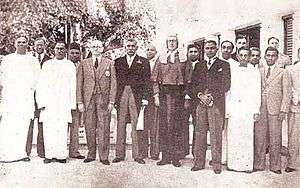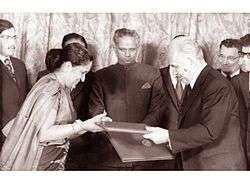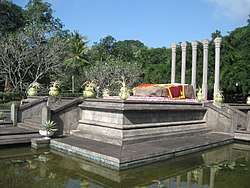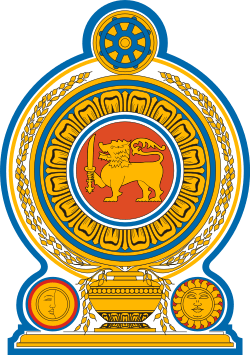S. W. R. D. Bandaranaike
| Hon. S.W.R.D. Bandaranaike | |
|---|---|
.jpg) S. W. R. D. Bandaranaike | |
| 4th Prime Minister of Ceylon | |
|
In office 12 April 1956 – 26 September 1959 | |
| Monarch | Elizabeth II |
| Governor General | Oliver Ernest Goonetilleke |
| Preceded by | John Kotelawala |
| Succeeded by | Wijeyananda Dahanayake |
| Leader of the Opposition | |
|
In office 9 June 1952 – 18 February 1956 | |
| Prime Minister | Dudley Senanayake |
| Preceded by | N. M. Perera |
| Succeeded by | N. M. Perera |
| Chairman of the Sri Lanka Freedom Party | |
|
In office 2 September 1951 – 26 September 1959 | |
| Succeeded by | C. P. de Silva |
| Minister of Health and Local Government | |
|
In office 26 September 1947 – 12 July 1951 | |
| Prime Minister | D. S. Senanayake |
| Preceded by | Position established |
| Succeeded by | Dudley Senanayake |
| Member of the Ceylon Parliament for Attanagalla | |
|
In office 14 October 1947[1] – 26 September 1959 | |
| Preceded by | Constituency established |
| Succeeded by | James Obeyesekere |
| Personal details | |
| Born |
8 January 1899 Colombo, British Ceylon |
| Died |
26 September 1959 (aged 60) Colombo, Dominion of Ceylon |
| Political party |
Sri Lanka Freedom Party (1951-1959) United National Party (1946-1951) |
| Spouse(s) | Sirimavo Bandaranaike |
| Relations | Panini Ilangakoon (Cousin) |
| Children |
Sunethra Chandrika Anura |
| Residence | Horagolla Walauwa |
| Alma mater | Christ Church, Oxford |
| Website | Official website |
Solomon West Ridgeway Dias Bandaranaike (Sinhalese: සොලමන් වෙස්ට් රිජ්වේ ඩයස් බණ්ඩාරනායක,Tamil: சாலமன் வெஸ்ட் ரிட்ஜ்வே டயஸ் பண்டாரநாயக்கா; 8 January 1899 – 26 September 1959), frequently referred to as S.W.R.D. Bandaranaike, was the fourth Prime Minister of Ceylon (later Sri Lanka) and founder of the left wing and Sinhala nationalist Sri Lanka Freedom Party, serving as Prime Minister from 1956 until his assassination by a robed Buddhist monk in 1959.[2][3][4]
Early life and education
Bandaranaike was born in Colombo, Ceylon, to the wealthy Sinhalese Anglican Christian Bandaranaike family, who had become one of the elite native families under the British administration.His ancestry is traced to Telugu Nayaks of Kandy. His father was Sir Solomon Dias Bandaranaike the Maha Mudaliyar[note 1], while his mother was Daisy Ezline Obeyesekere, daughter of Sir Solomon Christoffel Obeyesekere, a member of the Legislative Council of Ceylon. Sir Solomon named his only son after West Ridgeway, the Governor of Ceylon at the time, who was his godfather. He had two sisters Alexandra Camelia and Anna Florentina.[5]
He was tutored at home at the Horagolla Walauwa in Attanagalla by an English tutor, and for a short time attended S. Thomas' College, Mutwal, boarded at the Warden Rev. William Arthur Stone’s residence. He passed the Cambridge senior examination with distinctions in English, Latin, Greek and French gaining the second in order of Merit in the British Empire that year. He entered Christ Church, Oxford. He read for Philosophy, Politics and Economics and graduated with honors in modern greats in 1923. At Oxford, he was the Secretary of the Oxford Union and the President of the Majlis Society; his contemporaries at Oxford included Anthony Eden. In 1924, he was called to bar as a Barrister in the Inner Temple; on his return to Ceylon, he took oaths as an Advocate of the Supreme Court of Ceylon.[6]
Early political career
After his return from Britain, Bandaranaike became active in local politics. He got elected as the Chairman of the Nittambuwa Village Committee in his family seat. He became Secretary of the Ceylon National Congress (CNC) in 1926, and in December the same year was elected from the Maradana Ward to the Colombo Municipal Council, defeating the trade unionist A. E. Goonesinha.
State Council

Following the implementation of the Donoughmore Constitution, the State Council of Ceylon was established as the first legislator in the island with its members elected through universal suffrage. Bandaranaike contest and was elected unopposed from Veyangoda at the 1931 election to the first State Council and was elected to the executive committee for local administration, chaired by Charles Batuwantudawe. He stated in the council that the committee system introduced in the new constitution was satisfactory at the time.
Minister of Local Administration
In 1936, he was re-elected unopposed from Veyangoda in the 1936 election to the second State Council. In its first meeting, he was elected as Minister of Local Administration. As Minister, he was chairmen of the executive committee on local administration, of which he had been a member in the previous term and was a member of the Board of Ministers.
Sinhala Maha Sabha
In order to promote Sinhala culture and community interests, Bandaranaike founded the Sinhala Maha Sabha in 1936. He introduced the Free Lanka Bill in the State Council in 1945[7] In 1947, when Leader of the House, D. S. Senanayake presented the Soulbury Constitution to the State Council, Bandaranaike seconded the motion stating that he does so as the Sinhala Maha Sabha was the largest party in the State Council.
With Ceylon heading for self rule under dominion status, D. S. Senanayake invited Bandaranaike to combine his Sinhala Maha Sabha with other smaller parties into the United National Party (UNP) which Senanayake was forming to contest for the 1947 election under the new Soulbury Constitution. Bandaranaike accepted the invitation, formally dissolving the Sinhala Maha Sabha and merging with the UNP.
First Cabinet Minister of Health and Local Government

.jpg)
He contested for the newly formed House of Representatives in the 1947 election from the UNP from Attanagalla, winning with a good majority. In September 1947, D. S. Senanayake appointed him to his cabinet as the first Minister of Health and Local Government of Ceylon and he was elected as the Leader of the House. Effectively this made Bandaranaike the most senior member of the cabinet, after the Prime Minister. In fact, Senanayake had Sir Oliver Goonetilleke discuss with Bandaranaike as leader of the Sinhala Maha Sabha, the draft agreements for independence; which Bandaranaike received with mixed feelings. However, he did not object and the agreements signed with the Britain government making way for Ceylon to gain self-rule. As leader of the house, he delivered the address of thanks at the ceremonial opening of parliament on 4 February 1948, which marked Ceylon's independence from Britain.
During the next few years, he supported legislation proposed by the government as leader of the house. This included the Ceylon Citizenship Act No. 18 of 1948 and the Indian and Pakistani Residents (Citizenship) Act No.3 of 1949 which deprived citizenship to Indian Tamils. He initiated several projects for the improvement of health as minister of health, including the expansion of hospitals and uplifting ayurveda medicine. He attended the Third World Health Assembly in Geneva in May 1950 as Chief delegate of Ceylon. However, he found himself at odds with Senanayake administration on policy. By 1951, it also appeared that Senanayake did not intend to make an early retirement that would have allowed Bandaranaike to succeed him as prime minister.
Cross over and formation of the Sri Lanka Freedom Party
In July 1951, Bandaranaike resigned from his government posts and cross the floor to the opposition with several of his close associates from the Sinhala Maha Sabha. Thereafter he dissolved the Sinhala Maha Sabha and formed a new party, the Sri Lanka Freedom Party (SLFP) having its inaugural meeting at Town Hall on 2 September 1951.[8]
A few months later, on 21 March 1952 D. S. Senanayake fell off his horse after suffering a stroke and died the following day. Although Sir John Kotelawala was expected to succeed him, his son Dudley Senanayake, Minister of Agriculture was appointed Prime Minister on 26 March 1952 by the Governor-General Lord Soulbury. Dudley Senanayake called a general election in 1952, which the UNP won gaining 54 seats in parliament.
Leader of the Opposition
Bandaranaike contested the general election from the SLFP for the Attanagalla seat and was re-elected. With the SLFP gaining nine seats and the LSSP gaining nine. Bandaranaike was elected Leader of the Opposition. The leftist agitated Hartal 1953 affected Senanayake, who shortly stepped down. Kotelawala succeeded him as prime minister.
Pancha Maha Balavegaya
Between 1952 to 1956, Bandaranaike spent much of its time consolidating the new party. Although it drew many supporters from the old Sinhala Maha Sabha, it was still relatively new facing a lack of funds and the lack of support from mess media as it could not afford a party newspaper. It drew much of its support from the rural areas that were marginalized or neglected by the incumbent UNP government which was pro-establishment. On the issue of language, the party originally espoused the use of both Sinhala and Tamil as national languages, but in the mid-1950s it adopted a "Swabasha" (native language) policy. The party asserted itself as a champion of the Buddhist religion; the SLFP has thus customarily relied upon the socially and politically influential Buddhist clergy (the Sangha) to carry its message to rural Sinhalese. Since the 1950s, SLFP platforms have reflected the earlier organization's emphasis on appealing to the sentiments of the Sinhala masses in rural areas. To this basis has been added the anti-establishment appeal of non-revolutionary socialism. Bandaranaike continued his policies stated in 1952, on language, Buddhism, and Ayurvedic medicine. As such he stated that the basis of the party would be the ‘Pancha Maha Balavegaya’ (Five Great Forces) which consisted of the native doctors, clergy, teachers, farmers and workers.[9]
Mahajana Eksath Peramuna and the 1956 elections
In 1956, Kotelawala called for early elections. Bandaranaike responded by assembling a coalition with a group of small Marxist parties to form the Mahajana Eksath Peramuna (MEP) to contest the 1956 general elections. The MEP was a four-party coalition with a no-contest pact with the Lanka Sama Samaja Party and the Communist Party of Sri Lanka. Although he inherited his father's vast estate at the death of Sir Solomon in 1946, he was riddled with death duties. Short on funds for the election, Bandaranaike mortgaged his town house at Rosmead Place to the Bank of Ceylon for Rs 200,000; which he used for his campaign.
Prime Minister
The 1956 elections was a landslide victory for the MEP as it gained a two-thirds majority in parliament and Bandaranaike was invited by the Governor General to form a government as the fourth prime minister of Ceylon in April 1956. He formed his cabinet with a collection of senior members of the parties that made up the MEP and several independents.
National policies
He suspended all British and native honors and enacted the Suspension of the Capital Punishment Act No 20 of 1958, which suspended the death penalty from May 1958.
Language policy and communal tension
One of Bandaranaike's most notable actions was the implementation of the Sinhala Only Act, making Sinhala the sole official language of the country, downgrading the official status of English, and promoting socialist, non-Western policies that profoundly changed the course of Ceylonese politics in the following decades. He is also remembered by the minority Sri Lankan Tamils for his failure to use the state's resources to control the 1958 riots, leading to the deaths of many Tamil citizens at the hands of mobs. The government declared a state of emergency on 27 May after six days of riots. The Tamil Language Special Provisions Act was passed to mitigate the effects of the Sinhala Only Act.
Foreign policy
As prime minister, he took a neutralist stance in foreign policy, but established diplomatic relations with the People's Republic of China and the Soviet Union. He removed the British air bases at RAF Negombo and RAF China Bay and the naval base at Trincomalee. In 1957, he signed the Bandaranaike–Chelvanayakam Pact but was forced to withdraw in 1958.
Economic policy
Domestically, he was faced with economic problems and disputes over languages stemming from the Sinhala Only Act. He reformed labor laws and increased wages; established the Employees' Provident Fund and declarers May day a public holiday. The Paddy Lands Bill was introduced by is government to protect peasant farmers. In 1958, he nationalized bus companies and formed the Ceylon Transport Board and the Colombo Port Cargo Operations.
Strikes and cabinet crisis
In early 1959, a cabinet crisis resulted in the resignation of the leftist Philip Gunawardena and William de Silva. However the MEP remained intact. In 1959 trade unions at Colombo Harbour went on strike crippling imports and exports. Bandaranaike requested that the police intervene against trade union action, the order was declined by IGP Osmund de Silva on the grounds that he believed it to be unlawful. In April 1959, de Silva was compulsorily retired from the police force and M. Walter F. Abeykoon, a civil servant and Bandaranaike's bridge partner at the Orient Club, was appointed in his place.[10][11][12][13]
Assassination

Bandaranaike died four years into his term, aged 60 on 26 September 1959, at the Merchant's Ward of the Colombo General Hospital due to wounds sustained after being shot by Talduwe Somarama, a Buddhist monk.
On 25 September, Somarama had visited Bandaranaike at his private residence, Tintagel, in Rosmead Place, Colombo. Since Somarama appeared to be a member of the Buddhist clergy, he was not searched for weapons and given free access to the prime minister as he began his routine meetings with the public. The monk then fired a revolver at Bandaranaike as the latter stood to greet him; he was rushed to hospital but died the following day despite six hours of surgery by Ceylon's most skilled surgeons. A Supreme court trial found Somarama, Mapitigama Buddharakkitha, H.P. Jayewardena guilty and pronounced on all three of them the death sentence (death by hanging). Although Bandaranaike's administration had suspended capital punishment, Talduwe Somarama was hanged on 6 July 1962. It was claimed by the court that the reason for the murder of the Bandaranaike, was due to Bandaranaike's refusal to entertain Buddharakitha Thero's requests following his support for Buddharakitha in the election.
After Bandaranaike's death, Wijeyananda Dahanayake, minister of education and the Leader of the House, was appointed caretaker prime minister by Parliament. However, he fell out of favor with the members of the government, resulting in the removal of all ministers of the Bandaranaike's cabinet in less than a year. Eventually, the leadership of the Sri Lanka Freedom Party fell to Bandaranaike's widow Sirima Ratwatte Dias Bandaranaike who held the SLFP to an election victory in July 1960 becoming the world's first female Prime Minister and was soon appointed a Senator.
Family life

In 1940, he married Sirima Ratwatte, Barnes Ratwatte Rate Mahatmaya, later Dissawa of Sabaragamuwa. Ratwatte was an old Radala family hailing from the Kingdom of Kandy and the Bandaranaike's were an old and wealthy family from the low-country which had been in service of the colonial rulers for centuries. The wedding was dubbed "the wedding of the century" and linked Bandaranaike with the Kandian elite through marriage.[14]
The newly married couple moved into Wentworth in Guidford Crescent, Colombo which was taken on rent from Lionel Wendt. Their first two children, Sunethra and Chandrika were born and the family stayed at Wentworth till 1946, when Sir Solomon bought a mansion at Rosmead Place, Colombo and the family settled into it. Here their only son Anura was born. Following the death of his father Sir Solomon, Bandaranaike inherited the family seat of Horagolla Walauwa in Atthanagalla. Atthanagalla became the his home constituency for the future elections and remained the home constituency of his wife, daughter and son.
Sirima Ratwatte Dias Bandaranaike, as she was known after her marriage, became the first female prime minister in the world following Bandaranaike's assassination. His daughter Chandrika Kumaratunga subsequently became Prime Minister (1994) and then first female Executive president in the country, his only son Anura Bandaranaike went on to become Speaker of the Parliament of Sri Lanka (2000–2001) and a Minister (2004–08) and his eldest Sunethra Bandaranaike who followed her father's footsteps attending Oxford, became a prominent socialite.
Legacy
Both a highly respected and controversial figure, he has been accused of initiating the racial discords in the island nation with his pro-Sinhalese nationalist policies.[15] His wife continued many of his socialist policies in later years of her administration.
On 17 July 1976, a bronze statue of S. W. R. D. Bandaranaike was unveiled on Galle Face Green, it was sculpted by Lev Kerbel and gifted from the Soviet Union.[16] The Bandaranaike Memorial International Conference Hall was gifted from the People's Republic of China in his memory in 1970 and houses the S W R D Bandaranaike Museum.[17] The Bandaranaike International Airport, the first international airport in Ceylon was named in his honor when it was opened in 1970.
Honours
.svg.png)
See also
Notes
- ↑ The native aide-de-camp, chief native interpreter and adviser to the Governor of Ceylon
References
- ↑ "Sessions of Parliament". parliament.lk. Parliament of Sri Lanka. Retrieved 17 May 2018.
- ↑ "S.W.R.D.Bandaranaike, or Solomon West Ridgeway Dias Bandaranaike (Prime Minister of Sri Lanka)". Britannica Online.
- ↑ "Bandaranaike, Solomon West Ridgeway Dias". History.Com.
- ↑ "Solomon West Ridgeway Dias Bandaranaike". Encarta.MSN. Archived from the original on 1 April 2008.
- ↑ Nyrop, Richard (1982). Sri Lanka, a Country Study. Supt. of Docs., U.S. G.P.O. p. 197.
- ↑ S.W.R.D. Bandaranaike
- ↑ Richardson, John (2005) Paradise Poisoned: Learning about Conflict, Terrorism, and Development, International Center for Ethnic Studies, Kandy, Sri Lanka, p. 144, ISBN 955-580-094-4
- ↑ Richardson (2005), Paradise Poisoned, p. 145.
- ↑ Sepalika De Silva, Cultural practice of human rights: An anthropological study of human rights in Sri Lanka (2006), p. 57.
- ↑ Abayasekara, Anne (22 May 2011). "Times of triumph and tribulation written without fear or favour". Sunday Times. Retrieved 14 September 2016.
- ↑ "Parliamentary Debates". 36. Parliament of Sri Lanka. 1960: 115.
- ↑ "Parliamentary Debates". 36. Parliament of Sri Lanka. 1960: 162.
- ↑ "Operation Holdfast: Contours of a Coup Conspiracy". Daily Mirror. 2 November 2012. Retrieved 14 September 2016.
- ↑ SIVALI VIDYALAYA
- ↑ "Archived copy". Archived from the original on 9 February 2008. Retrieved 2 November 2007.
- ↑ Gift by USSR:Sculpting SWRD 'larger than life'
- ↑ Goh, Evelyn (2016). Rising China's Influence in Developing Asia. Oxford University Press. p. 146. ISBN 9780198758518.
External links
| Wikimedia Commons has media related to S. W. R. D. Bandaranaike. |
- The Bandaranaike Museum
- The Bandaranaike Ancestry
- The Ratwatte Ancestry
- Golden Memories of a Political Prodigy
- Commemorating the Bandaranaikes: The Emergence of the Political Middle-Class
- The Pensive Premier
- 49 Years after S.W.R.D. Bandaranaike
- Trail-Blazing Leader
- The Great Son of Sri Lanka
- Website of the Parliament of Sri Lanka
- Sri Lanka Freedom Party's official Website
This page incorporates text from the Library of Congress's Country Studies series.
| Political offices | ||
|---|---|---|
| Preceded by John Kotelawala |
Prime Minister of Ceylon 1956–1959 |
Succeeded by Wijeyananda Dahanayake |
| Preceded by |
Leader of Sri Lanka Freedom Party 1951–1959 |
Succeeded by C. P. de Silva |
